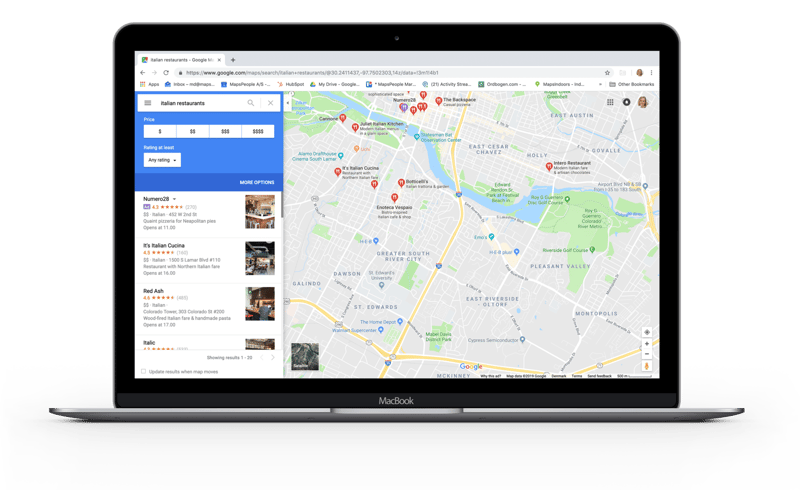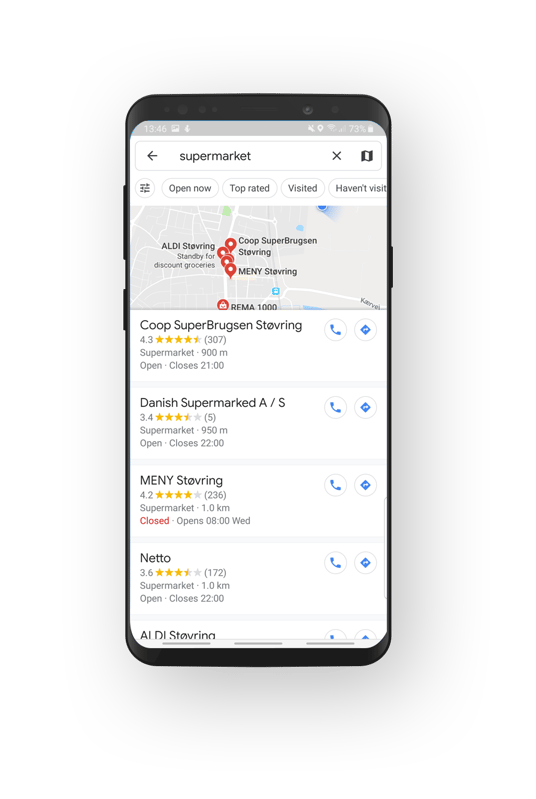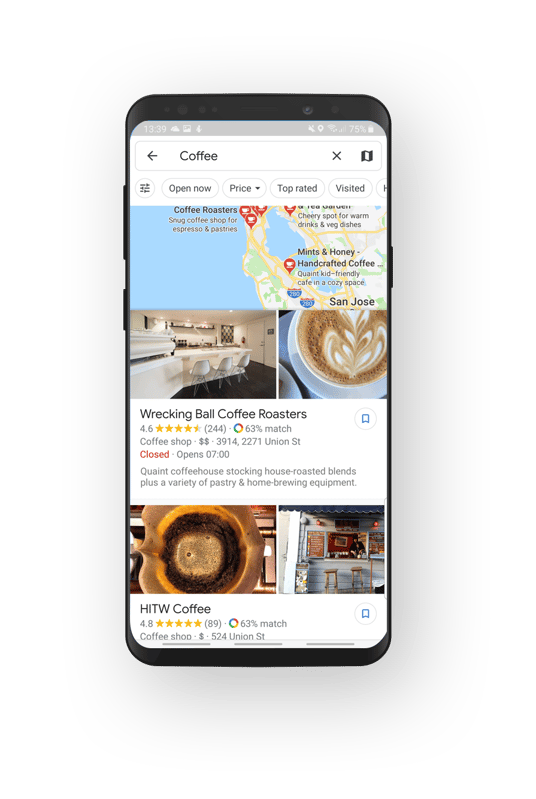One billion. That’s how many active users Google Maps has each month. Add to that the 25 million daily updates and the 99 percent coverage of the world. Needless to say, Maps is a powerful tool with an enormous reach.
If you’re using Google Maps yourself, you’re probably using it for more than just directions. Maybe you’re searching for a nearby coffee shop or a restaurant that matches your taste. In both cases a simple search in Google Maps will pull you a map with three results at the very top of the results page.
As a customer, you’re relieved to have all the information you need at your fingertips. However, as a business owner, you’re thrilled that Google Maps just gave you some advertising, and not to mention, a new customer.
This results page is a SERP feature called the Local 3-pack, sometimes also referred to as the Snack Pack. As 82 percent of consumers research online before visiting a store, optimizing for SERP features is essential in modern SEO.

Local beats global
It’s easy to think that online shopping is eliminating offline shopping, and while we're still waiting to see how the pandemic will leave its footprints in the retail business, off-line stores are still not out of the equation. A recent survey further shows that 53% of the participants would prefer shopping physically in their favorite stores after the pandemic, and 75% would return if given mobile coupons or special offers. This aligns with the "Research Online, Purchase Offline" (ROPO) effect which has been a trend on the rise for years.
Along with this, the trend up until the pandemic hit was clear: Around 90 percent of all global sales were still done in physical stores, and the use of mobile search isn't just boosting e-commerce anymore, it’s also boosting offline sales. In fact, three out of every four people who searched for something nearby using their smartphone end up visiting a store within a day, and 28 percent of those searches resulted in a purchase.
Speaking of mobile searches, nearly a third of these are related to location. Location-related searches have been growing 50 percent faster than mobile searches overall in the past years. Additionally, a survey of smartphone owners in the US showed that 82 percent of smartphone shoppers conduct ‘near me’ searches and more than 90 percent also said they were likely to click on the first set of results.
Searching for a coffee shop, a supermarket, or a specific type of business in Google Maps shows intent. The consumers know what they’re looking for, they just need the most convenient location that offers it. So, as a local business you must have a local SEO-strategy that helps you reach the customers closest to you and lead them from their mobile device to your physical store, and that means going for the Local 3-pack.
Earn your spot in the Local 3-pack
Google Maps Marketing doesn’t play by the traditional SEO rules, but if you want to be among the top three search results, here’s a little information about how Google Maps ranks businesses.
Proximity
The search results in Google Maps relies heavily on proximity. Google Maps is designed to give searchers the most accurate and closets results based on his or hers location. So, if you type in ‘supermarket’, Google will pull you a list of nearby supermarkets with the supermarket closest to your location as the top result, followed by the second closet, etc.
 The good news about the proximity ranking is that the big chains can’t out-optimize the small, local businesses unless they’re actually closest to the searcher (and vice versa), so it’s a fair fight, so to speak. However, the bad news is there’s not much you can do, if you don’t happen to be the closest supermarket.
The good news about the proximity ranking is that the big chains can’t out-optimize the small, local businesses unless they’re actually closest to the searcher (and vice versa), so it’s a fair fight, so to speak. However, the bad news is there’s not much you can do, if you don’t happen to be the closest supermarket.
Ratings and reviews
Proximity is the most common factor when it comes to Google Maps’ ranking, but it’s not the only one.
If searchers haven’t turned on location settings or if they’re looking for businesses that are not close to them, for instance, researching must try restaurants at their holiday destination, Maps relies on ratings and reviews rather than proximity.
A business’ rating is the average number of stars given by its visitors. Usually, the business with the best rating will be at the very top of the results page, but not always. The number of reviews also affects the ranking, so a coffee shop with with a 4,6 rating and 224 reviews may beat a coffee shop with a 4,8 rating and only 89 reviews.
 Neither good ratings nor endless reviews guarantee you the top spot in the Local 3-pack, but they increase your chances of getting it. Luckily, there are more things you can do to improve your Google Maps ranking, so be sure to tune in next week, when we dive into Google My Business optimization. In the meantime check out our blog for more Google Maps news and tips and tricks. We make sure to always bring you the best content.
Neither good ratings nor endless reviews guarantee you the top spot in the Local 3-pack, but they increase your chances of getting it. Luckily, there are more things you can do to improve your Google Maps ranking, so be sure to tune in next week, when we dive into Google My Business optimization. In the meantime check out our blog for more Google Maps news and tips and tricks. We make sure to always bring you the best content.

.png?width=220&name=Google_Premier_Partner%20(1).png)